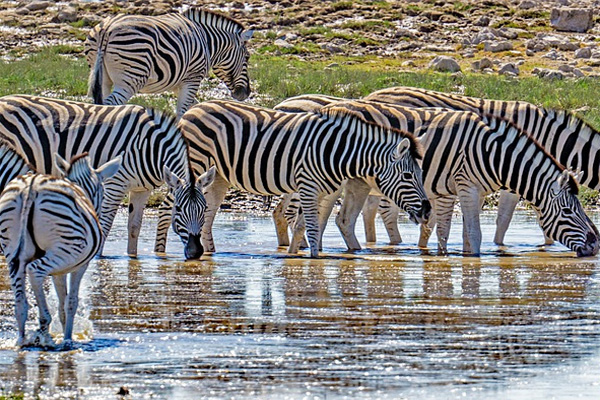Travel Pages
RomWell Travel Advisory
Beautiful African National Parks
There are no words to describe African National Parks. If you decide to visit some of them, we can only say that it will be a trip you will not forget in a hurry.
Africa is a world of wonders, a vast stretch of land filled with undiscovered sights and unfelt experiences, so, if you want to experience real Africa, choose a good travel company which can deliver top African trips.
Africa has over 3,000 protected areas, with 198 marine protected areas, 50 biosphere reserves, and 80 wetlands reserves. Significant habitat destruction, increases in human population and poaching are reducing Africa's biological diversity and arable land. Human encroachment, civil unrest and the introduction of non-native species threaten biodiversity in Africa. Find out more...
African Wildlife Foundation - For more than 40 years, the African Wildlife Foundation (AWF) has focused exclusively on the continent of Africa. Through these years AWF has played a major role in ensuring the continued existence of some of Africa's most rare and treasured species such as the elephant, the mountain gorilla, rhinoceros and cheetah. AWF has invested training and resources in African individuals and institutions that have gone on to play critical roles in conservation.
Blyde River Canyon Nature Reserve - Located in the north-eastern part of South Africa and famous for some of the most breathtaking panoramas in the world, the Blyde River Canyon is the third largest canyon in the world 26 946 ha, after the Grand Canyon in the United States and the Fish River Canyon in Namibia, and is the largest 'green canyon' due to its lush subtropical foliage, with the deepest precipitous cliffs of any canyon on the planet. One of the most-visited attractions in South Africa, the Blyde River Canyon is 26 kilometres in length and is, on average, around 800 m deep. The dam itself, when full, is at an altitude of 665 m (2182 feet).
South African National Parks - This site hosts details of South African National Parks, their camps and wildlife and community relations. It will help tourists and visitors with planning trips to the parks - self drive safaris, game viewing, accommodation tariffs, adventure activities such as guided walks and hiking, bird-watching, 4x4 trails, site seeing, cultural and historical experiences, mountain biking, golf, canoeing, swimming and many more. You can also learn how to become an honorary ranger or how to take part in organised events within these conservation areas.
Etosha National Park in Namibia - The Etosha Pan dominates the park. The salt pan desert is roughly 130 km long and as wide as 50 km in places. The salt pan is usually dry, but fills with water briefly in the summer months, when it attracts pelicans and flamingos in particular. Periannual springs attract a variety of game and birds throughout the year, including the endangered Black Rhinoceros and the endemic Black Face Impala.
Namib Naukluft Park - The Namib Naukluft Park is an ecologically protected area and was proclaimed in August 1979. The Park has an area of 49,800 km² and at the time of proclamation it was the largest protected area in Namibia.
Uganda Wildlife Authority (UWA) - UWA is mandated to ensure sustainable management of wildlife resources and supervise wildlife activities in Uganda both within and outside the protected areas. With 10 national parks and 12 wildlife reserves under its jurisdiction, UWA’s role in managing the country’s tourism industry and attracting investors to the sector has been a significant one. It also manages five community wildlife management areas and 13 wildlife sanctuaries. Uganda Wildlife Authority (UWA) is a semi-autonomous government agency that conserves and manages Uganda’s wildlife for the people of Uganda and the whole world. This agency was established in 1996 after the merger of the Uganda National Parks and the Game Department, and the enactment of the Uganda Wildlife Statute, which became an Act in 2000. Uganda is No. 2 in Africa and No. 9 in the world in terms of mammal species.
Chobe National Park - Chobe National Park is a true wildlife paradise and one of the best national parks in Southern Africa. Just one peek at the variety of wildlife and lush vegetation and you will be mesmerized forever!
Hwange National Park - Hwange is the largest and best known of Zimbabwe’s national parks. At 15 000 km² this immense wildlife reserve is packed with big game and is famous for massive numbers of buffalo and - in particular – its elephant herds. Indeed, Hwange’s 30 000-strong elephant population is the second largest in the world after the Chobe National Park in neighbouring Botswana.
World Parks Page - Get familiar with the parks all over the world.
More About Africa - Africa is an unexplored treasure waiting to be discovered. For anyone who has traveled and has the desire to see new places, countries and experience new cultures, Africa should be on the list of destinations. In Africa, travelers will not only find adventure, rough terrain, sophisticated and luxury travel, eye-opening natural scenery and the wonderful wildlife, but all travelers to incomparable Africa will also find a bit of themselves they never experienced before.



